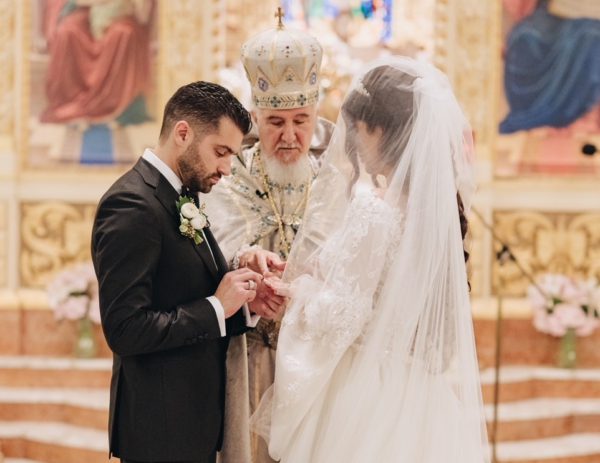By: Mollie Barnes

Father Hrant Yeretzian (middle), USC OHNS patient navigator Erika Arezomanians (right), and her husband David Dallakian (left). Photo Credit: Moosho Khachikyan
‘Find your voice’ is a common expression in English. Mostly when people say this, it means to find your passion or your ability to be understood. There is great weight put on someone’s voice, and this has been true throughout history. Orators and singers were honored. Before written word, it was our best way to communicate. It arguably still is, as there’s much more that can be said with tone of voice and the way someone says something than can be construed over a text message.
“We all rely so much on our voice to communicate, it’s the primary way we communicate,” says Dr. Michael Johns III, MD, director of the USC Voice Center and a professor at USC Caruso Department of Otolaryngology – Head and Neck Surgery. “Ranging from simple interactions, to performance voice, and to ministry and spirituality. And in order for us to have an effective voice, it requires us to have healthy vocal folds.”
In 2014, Father Hrant Yeretzian, a 75-year-old Armenian priest, underwent surgery at an outside hospital to remove vocal cord polyps. Unfortunately, his vocal cords ended up with scar, leading to significant loss of vocal capabilities. That meant he was also unable to chant or lead mass—his great joy in life and his main ministry.
“For nine months, I couldn’t talk at all,” Yeretzian says. “I told him I wouldn’t file a lawsuit, but I’m a priest, I need my voice. I need to talk, to lecture, to deliver sermons, to chant. Now, I can’t. I’m handicapped.”
After spending years trying to recover his voice with his initial surgeon, a specialist, and speech pathologist, his regional laryngologist finally recommended that he come to Keck Medicine of USC to see Dr. Johns in 2021 to try a new regenerative treatment using platelet rich plasma. This injectable comes from a patient’s own blood and is made of a substance that has shown promising regenerating properties in fields like cosmetic surgery and hair loss.
“In order for us to have an effective voice, it requires us to have healthy vocal folds,” says Dr. Johns, a laryngologist at Keck Medicine. “The vocal folds have a delicate soft mucous membrane layer that vibrates. They need to be able to vibrate in a regular kind of way for a voice to kind of come out. When the vocal fold mucus membrane gets injured, it doesn’t regenerate like other tissue. It heals with a defect in the healthy vocal fold tissue or with scar tissue, which makes for stiffer vocal folds that don’t vibrate as well.”
The platelet rich plasma has growth factors which induce healing and tissue regeneration, Dr. Johns says. In the long run, it can replace or induce your body to grow back some of the healthy vocal fold tissue.
“It’s not perfect; it’s not a transplant,” Dr. Johns says. “But since we started this clinical trial in 2020, we’ve demonstrated that this treatment is safe and everyone had some positive benefit of variable degree.”
Yeretzian says he’s noticed a huge change in what he can do with his voice now after receiving the injections.
“I used to be an operatic singer,” Yeretzian says. “For years after my surgery, I couldn’t do anything. Now, at least I can do it a bit better.”
He still can’t sing like he used to, but he performs weddings and christenings and can celebrate divine liturgy.
“I see an improvement every time I come in for a treatment,” he says. “I see a clearance in my voice. But I want it to be more. It is like a miracle to come and see a doctor like Dr. Johns, who can do something to repair my voice.”
Finding family
When Yeretzian first called Dr. Johns’s office, Patient Navigator Erika Arezomanians, who is also Armenian, called him to set up his first appointment. She immediately bonded with Yeretzian over their shared heritage.
“As a priest, when we visit our families, we don’t just go do our job and visit, we see them as our own family,” Yeretzian says. “We sit with them and ask about everything they have, if they have kids, what kinds of problems they’re facing and what do they need to know about their church and priest.”
What was once his patient navigator was now also his family.
“She became an adopted daughter for me,” he says. “Our duty is not just to bless people or talk to them when they need us. In our culture, we have two days in a year, Christmas and Easter, to visit families to bless their house. Besides that, we are ready to visit every single family when there’s a need for us to visit. That’s how I felt with Erika. She’s part of me and I’m a part of her.”
Yeretzian even performed Arezomanians’ wedding last year.
He says the whole team at USC, not just Arezomanians, helps make him feel at home when he comes in for his treatments.
“Every time I visit USC I feel like I’m visiting my family members,” Yeretzian says. “I feel very comfortable with all of them, even the girls at the window when I come and sign in. It helps the patient to feel more relaxed and more ready to go for their procedures without hesitation. Other times when you go see a doctor, they’re just doing it as a business, which makes a patient feel more nervous. When I come to USC, they put a smile on my face. Everything that they do makes me smile, so it makes it easier to recover.”